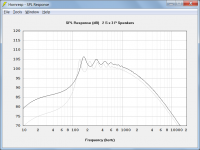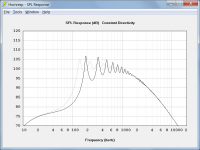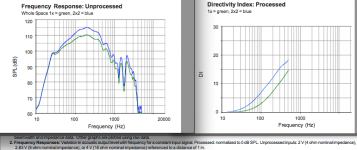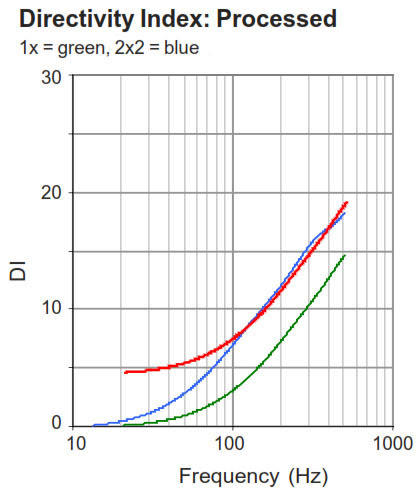So I am having trouble making heads or tails of horn grouping given the plethora of differing opinions on horn loading. From what it seems to me you can truncate the length and mouth size of a horn (while keeping the flare rate) and group the horns to the needed mouth size for a given frequency to get equivalent performance to a full size horn, of course assuming a similar acoustic loading environment. Am I missing something here? What am I not taking into consideration? Thanks all.
You can not truncate the length without raising the horn cutoff frequency.
Hi Art,
Just to clarify - it is perhaps worth making the distinction between the actual theoretical flare cutoff frequency of a horn, and the resultant practical low frequency response rolloff.
Horn length can be truncated without raising the cutoff frequency provided that the flare rate remains unchanged. For example, the following three exponential horns have the same throat areas and flare rates but different lengths - in each case, the cutoff frequency stays constant at 100 hertz.
S1 = 10.00
S2 = 2397.32
L12 = 150.00
F12 = 100.00
S1 = 10.00
S2 = 385.91
L12 = 100.00
F12 = 100.00
S1 = 10.00
S2 = 62.12
L12 = 50.00
F12 = 100.00
In other words, to be strictly correct it is actually flare rate that determines the horn cutoff frequency, not length.
As the horn is shortened however, the increasing mismatch at the mouth causes the ripples in the throat acoustical impedance to become larger, and the shorter length means that the ripples will be further apart in frequency. Both these things conspire to make the resultant response roll off at a higher frequency, even though the theoretical cutoff frequency of the horn has not changed.
Kind regards,
David
So... Theoretically, one would be able to group 6 horns with an L12 of 100 and S2 of 385 and get nearly the same effective mouth area and response as the longer, larger horn?
What got me thinking about all this was looking at Olson's paper that had response charts for different lengths of horns with the same flare cutoff and throat size and the responses were relatively similar, not taking into account the major impedance fluctuations presumably caused by small mouth sizes.
Thanks again David.
What got me thinking about all this was looking at Olson's paper that had response charts for different lengths of horns with the same flare cutoff and throat size and the responses were relatively similar, not taking into account the major impedance fluctuations presumably caused by small mouth sizes.
Thanks again David.
So... Theoretically, one would be able to group 6 horns with an L12 of 100 and S2 of 385 and get nearly the same effective mouth area and response as the longer, larger horn?
Hi dustman96,
I'm not sure that your observation above is strictly correct, but it seems you may get reasonably close - the black trace in the attached chart shows the Hornresp predicted power response for six 100 cm horns connected in a 2S x 3P array radiating into 2Pi space. The gray trace shows the response for a single 150 cm horn radiating into 2Pi space.
Kind regards,
David
Attachments
Hey David,
Thanks for running that through Hornresp and sharing. Pretty interesting. I wonder if the slightly smaller mouth area of the 6 horns as opposed to the long one makes the difference. I bet in the real world the coupling wouldn't be perfect so response might suffer slightly. I don't want to ask too much of you but if you have the time would you mind throwing just a single foreshortened 100cm horn onto that graph as well?
I don't know about you, but I find horns fascinating!
Dusty
Thanks for running that through Hornresp and sharing. Pretty interesting. I wonder if the slightly smaller mouth area of the 6 horns as opposed to the long one makes the difference. I bet in the real world the coupling wouldn't be perfect so response might suffer slightly. I don't want to ask too much of you but if you have the time would you mind throwing just a single foreshortened 100cm horn onto that graph as well?
I don't know about you, but I find horns fascinating!
Dusty
would you mind throwing just a single foreshortened 100cm horn onto that graph as well?
Hi Dusty,
For you, just this once only
That said - the black trace in the attached chart shows the Hornresp predicted power response for a single 100 cm horn radiating into 2Pi space. The gray trace shows the response for a single 150 cm horn, also radiating into 2Pi space. As expected, the response of the 100 cm horn is more "peaky" than that of the 150 cm horn because of the smaller mouth size and the resultant poorer mouth acoustical loading. Even though both horns have the same flare rate, and hence the same theoretical cutoff frequency, the longer horn has slightly better low-frequency extension for the reasons outlined in my earlier post to Art (weltersys).
Kind regards,
David
Attachments
...My very strong preference is for people to spend a little time learning how to use Hornresp so that they can try these things for themselves - it is by far the best way to learn, and to understand what is going on...
You are correct.
However, we don't all have Hornresp. And I'm sure a lot of others, like me, really don't have a need to mess with it.
Nevertheless, although I'm not building horns, I'm really curious to see this kind of stuff --> thanks for running the sims and posting them.
However, we don't all have Hornresp.
Hi head_unit,
That's no excuse
The program can be downloaded free of charge from Hornresp. It works on all Microsoft Windows operating systems. The current Setup.exe file is a little over 1MB in size.
Hornresp can also simulate direct radiator loudspeakers, not just horn-loaded systems.
Kind regards,
David
I don't think bass horns couple below 200hz.
take a eaw kf940.
http://www.eaw.com/products/KF940.html
http://www.eaw.com/info/EAW/Loudspeaker_Product_Info/Current_Loudspeakers/KF940/KF940 SPECS_revA.pdf
dual 12" bent bass horn.
13' long path, maybe 3-4ft2 of mouth.
This is their graph on their pdf sheet, not a simulation.
Notice how 4 boxes couple well at 200hz but not at all down around 30hz.

but you can boost the low end.
And 8 drivers (4 boxes) will handle 10db of boost better than 2 drivers.
take a eaw kf940.
http://www.eaw.com/products/KF940.html
http://www.eaw.com/info/EAW/Loudspeaker_Product_Info/Current_Loudspeakers/KF940/KF940 SPECS_revA.pdf
dual 12" bent bass horn.
13' long path, maybe 3-4ft2 of mouth.
This is their graph on their pdf sheet, not a simulation.
Notice how 4 boxes couple well at 200hz but not at all down around 30hz.

but you can boost the low end.
And 8 drivers (4 boxes) will handle 10db of boost better than 2 drivers.
Last edited:
Norman,I don't think bass horns couple below 200hz.
take a eaw kf940.
dual 12" bent bass horn.
13' long path, maybe 3-4ft2 of mouth.
This is their graph on their pdf sheet, not a simulation.
Notice how 4 boxes couple well at 200hz but not at all down around 30hz.
but you can boost the low end.
And 8 drivers (4 boxes) will handle 10db of boost better than 2 drivers.
Rest assured, bass horns do indeed couple below 200 Hz.
Also, 10 dB of boost is exactly the same with 2 drivers or 8, multiple voice coils just make a bigger fire
The increase in upper level of the EAW KF940 "unprocessed" chart is due to the increased upper directivity focusing more output level in front of the multiple cabinet array when compared to a single, while the mostly omnidirectional low bass has very little DI increase, and therefore relatively less gain in multiples.
The response of the low bass looks like it has hardly increased (about 1 dB at 30 Hz compared to about 4 dB at 100 Hz) because the drive voltage has been reduced in the multiple cabinet chart.
Art
Attachments
They do.I don't think bass horns couple below 200hz.
I don´t know, what EAW measured, but here is a measurement from the german "Production Partner"
An externally hosted image should be here but it was not working when we last tested it.
Hi head_unit,
That's no excuse.
The program can be downloaded free of charge from Hornresp. It works on all Microsoft Windows operating systems. The current Setup.exe file is a little over 1MB in size.
Hornresp can also simulate direct radiator loudspeakers, not just horn-loaded systems.
Kind regards,
David
When are we gonna get Hornresp for Mac?
When are we gonna get Hornresp for Mac?
Hi Dusty,
That's an easy one - never
Kind regards,
David
Hi norman bates,I don't think bass horns couple below 200hz.
take a eaw kf940.
EAW: KF940
http://www.eaw.com/info/EAW/Loudspeaker_Product_Info/Current_Loudspeakers/KF940/KF940%20SPECS_revA.pdf
dual 12" bent bass horn.
13' long path, maybe 3-4ft2 of mouth.
This is their graph on their pdf sheet, not a simulation.
Notice how 4 boxes couple well at 200hz but not at all down around 30hz.

but you can boost the low end.
And 8 drivers (4 boxes) will handle 10db of boost better than 2 drivers.
The coupling of multiple basshorns in a free field is determined by the sum of the mouths areas and their 1/4 wavelength.
In case of the KF940 the horn-mouth area is much smaller than its ¼ wavelength diameter. Actually, the mouth area is scaled down in a ratio of approx 16:1.
In other words, the KF940 is designed in such way that you will need 16 cabs (4 by 4 setup) to get a full coupling (horizontal and vertical) over the full bandwidth of the KF940.
The measurement is of an 2 by 2 stack which represents about a quarter of the area needed to get coupling over the full bandwidth. Therefore full coupling happens about 4 times higher somewhere around 120Hz as shown in the unprocessed frequency response.
- Status
- This old topic is closed. If you want to reopen this topic, contact a moderator using the "Report Post" button.
- Home
- Loudspeakers
- Subwoofers
- Horn grouping question.




